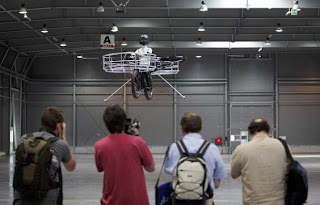Helix Rotations
The expression:
represents a counter clockwise helix (the constant 'i' is the imaginary operator). Using 'i' as a rotation operator, we see the helix rotate by 90 degrees counter clockwise when e^(i*x) is multiplied by 'i' as:
The two helices are drawn below (click to view):
How many of you would like to have a Flying Bicycle? A personal bike which can fly by electricity?
Thanks to the scientists, I always say that "the future is open!", So maybe one day you could purchase not only a flying bike but a Flying Star Wars Speeder Bike as well!
Contrary to popular belief, the Darlington Compound (or Darlington Pair) gain is not the product of the two individual transistor gains exactly, but is a little more complicated. We actually have two different gains to consider. As the drawing illustrates (click drawing to view), the gain of the first stage is B1+1 and so that gets amplified by the next stage which has a similar gain B2+1, so the combination is really the product of the two:
Gain=(B1+1)*(B2+1)
and that is the total gain from the input to the emitter of the Darlington.
The total Beta is just:
B=(B1+1)*B2+B1=B1*B2+B1+B2
and that is the total gain from the input to the collector of the Darlington.
For most practical circuits however, the gain is often approximated as simply B1*B2 because transistor gains (Beta's) are not exact anyway, and in addition there are resistors added to the bases of the two transistors as shown in the diagram. These resistors help reduce effects of leakage currents and also increases the switching speed of the combination.





